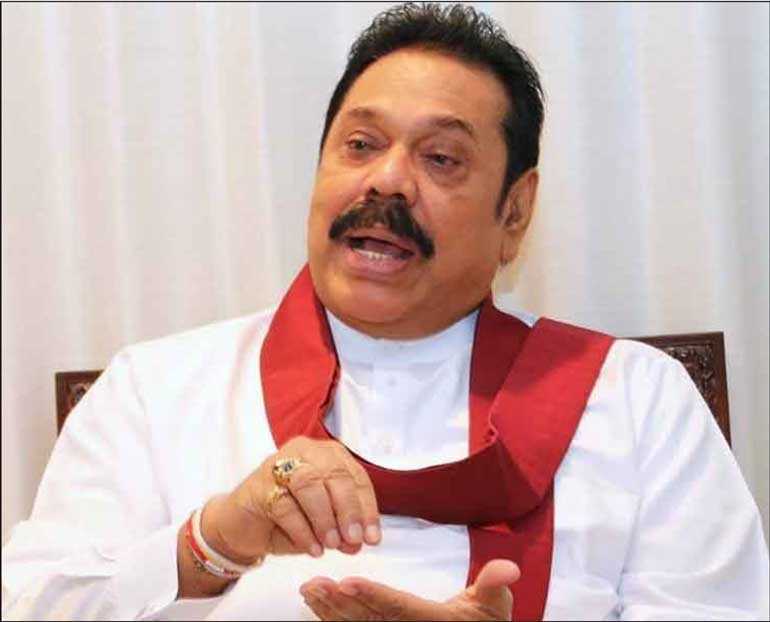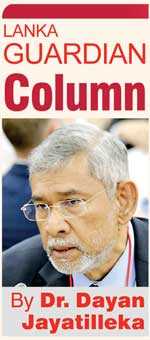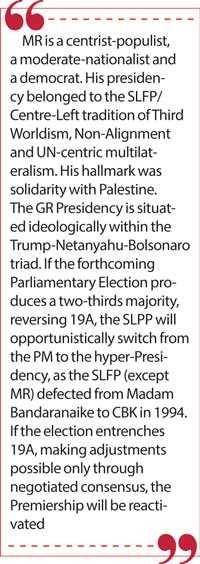Thursday Nov 28, 2024
Thursday Nov 28, 2024
Thursday, 4 June 2020 00:30 - - {{hitsCtrl.values.hits}}

Watching on TV Prime Minister MR’s empathy at the funeral of Arumugam Thondaman, I remembered the two of us walking back from the funeral of S. Thondaman in 1999, discussing politics (the upcoming Dec ’99 Presidential Election).
It was fitting indeed that the 50th anniversary of the entry to Parliament of Prime Minister Mahinda Rajapaksa was celebrated so close to the 11th anniversary of Sri Lanka’s victory over separatist terrorism. The latter anniversary marks the indelible historic achievement of Mahinda Rajapaksa, liberating his country as his presidential predecessors from President Jayewardene onwards could not, from the hellfire of terrorism. He won the war, brought peace.
Mahinda’s war
Since the instrumentality that won the war was the same military albeit with a reshuffled command, that had failed to beat the Tigers since it was first sent north in 1979 by President Jayewardene with orders to “eradicate terrorism in all its forms”, the most crucial variable becomes clear to the analyst, namely that of political will. Mahinda Rajapaksa had the confidence that Prabhakaran could be defeated, the political will to see it through to the end, and the determination not to be pressured or fooled as others had been, into stopping half-way.
It was Mahinda’s War, in quite the same sense as the American Civil War of Reunification was Lincoln’s war and the Allied fightback against the fascist Axis was Churchill’s, Stalin’s, Roosevelt’s and de Gaulle’s war. The wickedest thing that can be done to MR is to take that away from him or dilute, deflect and divert that unprecedented historical achievement. That historical revisionism came (in 2012) and still comes from within his camp.
There is no little pathos in observing the war-winning former President and current Prime Minister accorded a role of less prominence in national affairs and importance in decision-making than former and serving Army generals whom he towered over during the war as leader of the nation and Commander-in-Chief.
More: at the landmark postwar meeting of the National Security Council, the rift between President MR and General Fonseka was precisely over an expanded role for the military, and MR firmly refused, safeguarding civilian democracy, declaring “it is being said that this is already becoming like Myanmar!” (That factor made democratic India decisively support MR in the split and the 2010 election).
As a firebrand politician MR fought against Right-authoritarianism under UNP rule and especially the quasi-militarism of National Security Minister Lalith Athulathmudali and Deputy Defence Minister Ranjan Wijeratne.
Thus, pathos is enhanced by his recent signing-off on statements ideologically justifying the aberrant militaristic re-configuration of the State, with its abnormal inversion of constitutional roles.
Tracking the shift
There were two scenarios of the ‘Gotabaya as presidential candidate’ project. One was that GR would be to MR—and this was my version in 2016—what Raul Castro was to Fidel when ill-health forced the latter to relinquish leadership and function from retirement. This scenario failed. The dominant values, ideology and ethos of today’s GR regime are not those classifiable as MR’s. The other variant, the  scenario that succeeded, was that “MR’s time was over” and that GR was the leader who could implement, not MR’s vision, but a different one, that of the New Right or Radical Right, which included the Religious Right. This was being canvassed already in MR’s second term. This openly Sinhala-Buddhist supremacist ‘line’ could best be described as coming from the local ‘Tea Party movement’/Trump constituency or RSS-Shiv Sena, as distinct from MR’s constituency, the Sinhala nationalist-populist centre-left.
scenario that succeeded, was that “MR’s time was over” and that GR was the leader who could implement, not MR’s vision, but a different one, that of the New Right or Radical Right, which included the Religious Right. This was being canvassed already in MR’s second term. This openly Sinhala-Buddhist supremacist ‘line’ could best be described as coming from the local ‘Tea Party movement’/Trump constituency or RSS-Shiv Sena, as distinct from MR’s constituency, the Sinhala nationalist-populist centre-left.
Today, just as the 50th anniversary of MR as a parliamentarian provides ample evidence of why a political leader of his matchless experience and achievement should be the empowered Prime Minister enabled by the 19th Amendment, his own camp has dropped the slogan and has converted to the Far-Right slogan of ‘all power to the presidency’.
Mahinda is to Gotabaya what Vajpayee was to Advani and George HW Bush (George Bush Sr.) was to George W. Bush (George Bush Jr. aka “Dubya”), while MR’s constituency is to GR’s what the Republican party was to the Tea Party movement/Palin candidacy and the Trump constituency, or what Israel under Labor was to Israel under Likud.
This is most starkly seen in the difference between Mahinda’s policy on external relations as evidenced in his attitude to the UN-Geneva, Human Rights and India, and that of Gotabaya. MR’s vision of Sri Lanka’s stance and behaviour in the world was quite distinct from that of GR.
MR, as wartime President, was very mindful of his relationship with India and used it as a shield against Western interference. When in the closing stages of the war there was a US-Norway attempt to secure an evacuation and the goalposts of that evacuation changed as Hillary Clinton was influenced by her staffers, MR played the Delhi card to ward off the effort. In order to keep Delhi onside during the war, MR was willing to sincerely commit to the implementation of the 13th Amendment, with his own add-on, a Senate, hence “13 Plus”.
As Secretary/Defence, during most of the war GR was fully on board with that trade-off, but as the war was reaching its climax, and as he became more entranced by the Israeli model for the postwar order, he shifted to a more hawkish policy posture, which was more organically what he believed in, given his socialisation trajectory which contrasted with MR’s.
‘Soft power’ maestro
MR is the maestro of “soft power” and intuitively understood its international importance. The GR regime’s “soft power” has a range purely within its ethnocultural-civilisational zone.
MR’s relationship with the UN Human Rights Council, the UN-Geneva and Human Rights was one of complex engagement. As an opposition parliamentarian he travelled to and lobbied the UNHRC together with Vasudeva Nanayakkara. As Minister he visited Geneva and interacted with the ILO and the Inter-Parliamentary Union. As President (in 2007) he addressed the ILO, and dialogued with the ILO D-G, the UN High Commissioner for Human Rights, the UN High Commissioner for Refugees (the current UN Secy-Gen) and Amnesty International boss Irene Khan.
President MR’s Office never exhibited coarse insensitivity as manifested in a statement recently issued by the Media Division of President GR’s Office. The Hindu quotes the statement as saying, inter alia, the following:
“In any armed conflict, maintaining human rights of an individual is akin to preventing muddy puddles during rain.” …Due to the “volatile” nature of warfare, International Humanitarian Laws are “not a set of clear-cut rules in black and white that one may tick off against.” 
In a new article, Additional Secretary to the President on Foreign Relations, Admiral Prof. Jayanath Colombage queries: “This pandemic has brought to the fore the question; what matters most--human lives or economic prosperity and civil liberties?” (http://www.dailymirror.lk/opinion/Post-Covid-19-International-Order-Will-a-new-world-emerge/172-189200)
Why are these categories seen as polarities? Why are ‘civil liberties’ paired with economic prosperity rather than ‘human lives’? What will be the quality of human lives, with neither civil liberties nor economic prosperity? And how is the question relevant when the top performer in the anti-Covid 19 campaign has been a country and a leadership which zealously protects civil liberties and brings together ‘human lives’, ‘economic prosperity’ and ‘civil liberties’ in a social democratic synthesis, namely New Zealand led by Jacinta Ardern? What of another top anti-corona performer, Israel, which halted digital tracking through private mobile communications because the Supreme Court ruled that without the permission of Parliament it was a violation of the civil liberties of Israeli citizens?
On MR’s watch as President, Sri Lanka won a vote by a conspicuous majority in the UNHRC a week after the war was won (May 2009), and lost three times in succession during his second term when the hawks were in ascendancy and we had forfeited India’s support (2012, 2013, 2014). But there was never a question of walking out of the UNHRC as President Gotabaya Rajapaksa has threatened in a diaphanously-veiled reference. It would have been unthinkable for MR to walk out of the world’s Human Rights Parliament.
Under MR, SL’s UNHRC success in 2009 and its defeats in 2012, 2013 and 2014 had much more to do with the shifting Indo-Lanka equation than with the US. India was the crucial swing state. When India was firmly with us, it was because of President MR’s pledge, reinforced through the ‘Troika’, to implement 13A and open a political process with the TNA. When India was with us so was the rest of the BRICS and the Non-Aligned Movement. The West broke through in 2012, the moment we lost India, opening a breach.
Foreign relations
Why did MR delay in implementing his own written pledge as contained in the two postwar joint statements with India and the UN S-G? Why was the formula that ensured our international invulnerability abandoned?
Mere days after the 2009 UNHRC diplomatic victory, Dr. Gunadasa Amarasekara led, or was activated as proxy of, the ultranationalist counter-campaign against one of the main planks of the pro-SL platform at the UNHRC: President MR’s pledge to implement 13A.
The US Senate Foreign Relations Committee’s Kerry-Lugar Report of late 2009 proves that “political reconciliation” addressing the “root causes” through “the devolution of power to the provinces [and] a second chamber” and the prosecution of emblematic human rights cases would have rectified relations with the USA. In late 2009 India was still with us and our UNHRC victory kept us safe in Geneva, buying time. We could have clinched the deal.
President MR appointed the LLRC. Barring one suggestion, he agreed fully with the Report’s recommendations. Fast-track, time-bound implementation could have shielded us internationally. Instead implementation was blocked from within the system. Today, the GR regime never mentions the LLRC or Paranagama reports.
The last chance to dissipate international pressure with dignity came in 2013-2014, when MR finally held elections to the Northern Provincial Council and rebooted relations with the TNA. Reneging subsequently on the promise to India and the TNA to appoint a civilian governor and failure to leverage the “soft power” of South Africa which nominated Cyril Ramaphosa as special envoy, were due to hawkish obstructionism.
The Ranil-Mangala capitulation followed in 2015 in Geneva.
MR returns
MR’s 2015 bounce-back was the fastest turnaround in SL political history. Wartime leaders Churchill and De Gaulle made comebacks, so MR’s was do-able and probable, as I argued at the time. His personality apart, the concrete factors that facilitated, assisted and accelerated the comeback were:
(1) The Nov-Dec 2014 Presidential campaign itself (in which TV played a major role) was able to limit the defeat in that MR was able to retain the support of the majority of the Sinhala majority.
(2) The formula for the fightback (fronted by Dinesh Gunawardena, while already envisioning a breakaway party) was presented at Speaker Chamal Rajapaksa’s residence on 10 January, just two days after the defeat, and on the very afternoon that MR handed over the SLFP to President Sirisena (at the insistence of Ven. Athuraliye Rathana).
(3) What became the JO was informally assembled, and the Nugegoda rally organised by mid-February, as the operationalisation of that fightback formula.
(4) A grassroots campaign of political-ideological education mobilising the Pradeshiya Sabha members, organised by loyal MPs, rapidly unrolled—laying the basis for what would become the powerful SLPP.
(5) The Geneva 2015 resolution and the UNP-TNA drive for a weak non-unitary Constitution abolishing the executive presidency, were swiftly seized upon by pro-MR/JO opinion-makers at seminars and on TV, to raise public consciousness.
Arguably, had MR agreed to form a new party on the cusp of the August 2015 election—as I urged—he would have been stronger, sooner.
Losing the initiative
MR lost the initiative in 2018-2019. He was not backed by a Galle Face Green 2017 type SLPP mega-mobilisation during his 52-day Premiership. The powerful network of pro-GR social media sites fell silent, without providing covering fire. Yet it was not with the 52-day interlude that MR lost the initiative. Indeed, he finally became Opposition Leader thanks to that episode and the re-convergence with President Sirisena. The Sirisena-Mahinda synergistic experiment was bloodily validated when the restoration of a negligent, dysfunctional, neoliberal Establishment proved the portal for the Easter carnage.
Though Cardinal Ranjith had held the line for three weeks, the Islamophobic waves—Minuwangoda, Dr. Shafi, Ven. Rathana’s fast, etc.—broke through, cynically and ruthlessly propelled by the local Fox News equivalents, escalating and polarising the situation, wresting the initiative from MR, forcing his hand.
Losing the initiative and the political centre-of-gravity was not inevitable.
The initial Sinhala supremacist test-run of hijacking the Opposition through waves of Islamophobia was the Ampara “infertility pills” upheaval.
The strategic blunder was that the SLPP did not consistently become the vehicle either of “Mahinda Chinthana” values or the SLFP ideology which that party abandoned by collaboration with the UNP, or the ideology of the Joint Opposition and the Mahinda comeback movement which commenced on 18 February 2015 at Nugegoda. It could have done so, delegating ideology and program to progressive-centrists (e.g. Dulles Alahapperuma and Vidura Wickramanayake). Instead it competitively cultivated the same Sinhala-Buddhist supremacist, ultranationalist Right that the Viyath Maga/Eliya represented.
Prominent Sinhala supremacist ideologues Gevindu Kumaratunga and Dr. Channa Jayasumana (of Dr. Shafi fame) were more identified with the “BR-wing” than the “GR-wing”.
The next blunder was inviting Viyath Maga/Eliya speakers to indoctrinate audiences of the broad JO-SLPP, which were traditionally centre-left.
Instead of converting the Far-Right to the Middle Path and the middle ground of moderate, progressive patriotism—the ideological centre—the moderate Centre (including the Centre-Left) converted to the Far-Right.
As an individual, I had tried (2016-2018) and failed (2018) to vaccinate the GR project with ideological moderation, but the SLPP/JO could have succeeded.
The tragedy is that the Opposition comeback centred on and was powered by MR’s presence, personality and historic achievement, but that historic personality was manipulatively marginalised in a campaign that covertly commenced in his second term, surfaced openly in 2019, and is the extra-constitutional political reality today.
MR tomorrow
MR is a centrist-populist, a moderate-nationalist and a democrat. His presidency belonged to the SLFP/Centre-Left tradition of Third Worldism, Non-Alignment and UN-centric multilateralism. His hallmark was solidarity with Palestine.
The GR Presidency is situated ideologically within the Trump-Netanyahu-Bolsonaro triad.
If the forthcoming Parliamentary Election produces a two-thirds majority, reversing 19A, the SLPP will opportunistically switch from the PM to the hyper-Presidency, as the SLFP (except MR) defected from Madam Bandaranaike to CBK in 1994.
If the election entrenches 19A, making adjustments possible only through negotiated consensus, the Premiership will be reactivated.
MR and Sampanthan could negotiate a 13A based ‘final-status’ resolution—in 2011, MR suggested swaps within the Concurrent List—for President GR’s endorsement (and India’s underwriting).
If that’s over-ambitious, the restoration of republican constitutionality, balance, political normalcy and civic-democratic tradition through a rejuvenated Premiership—and a New Opposition with a youthful leader—in a new Parliament, would be the finest way to ensure Mahinda Rajapaksa’s legacy.